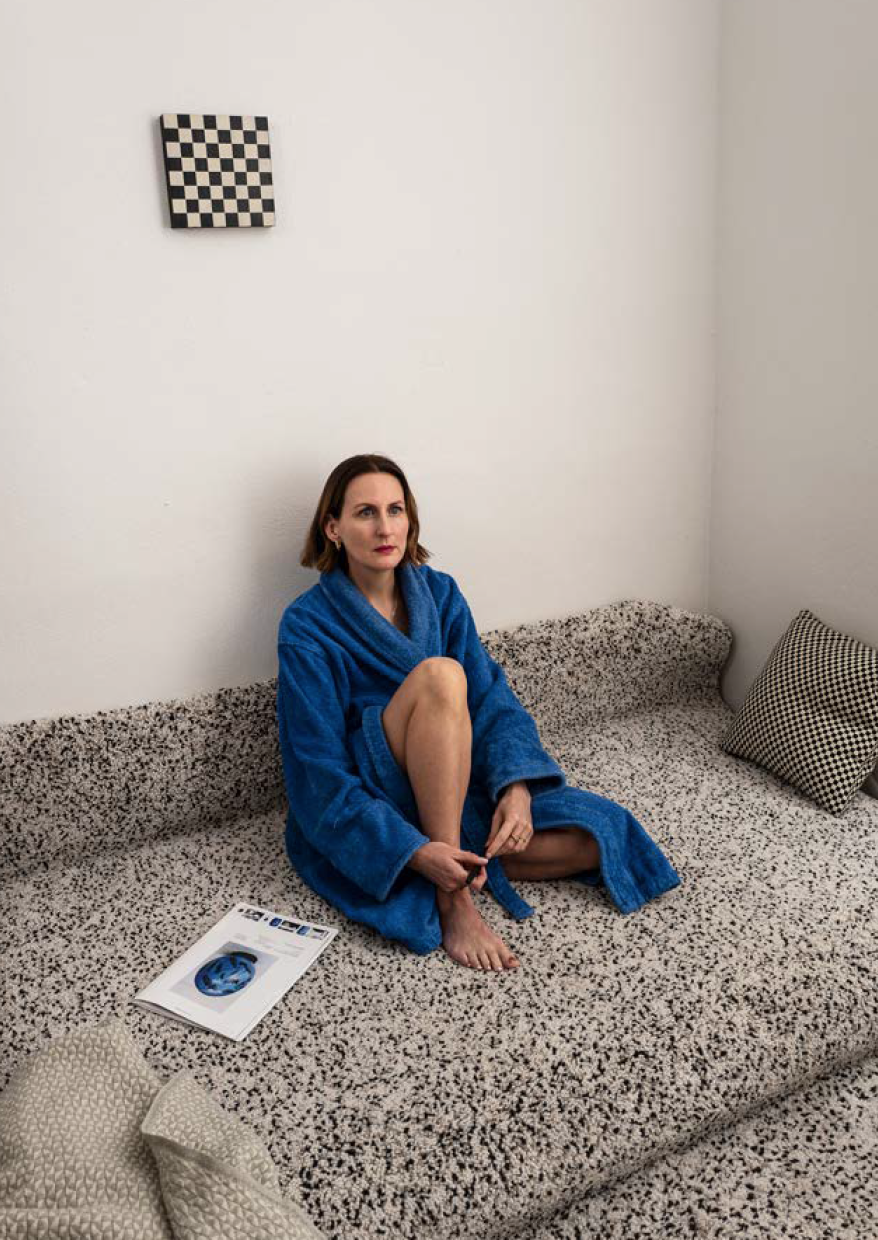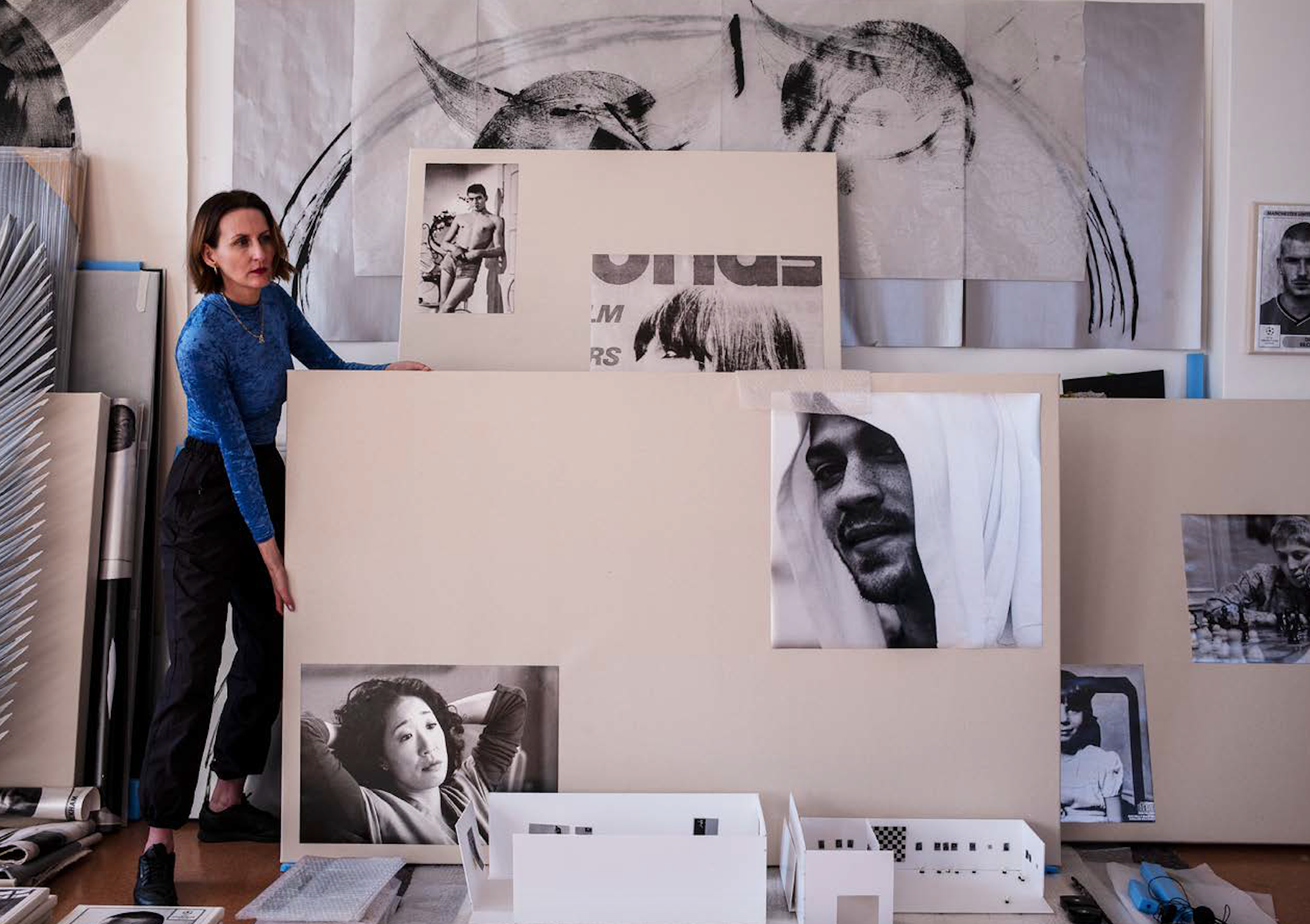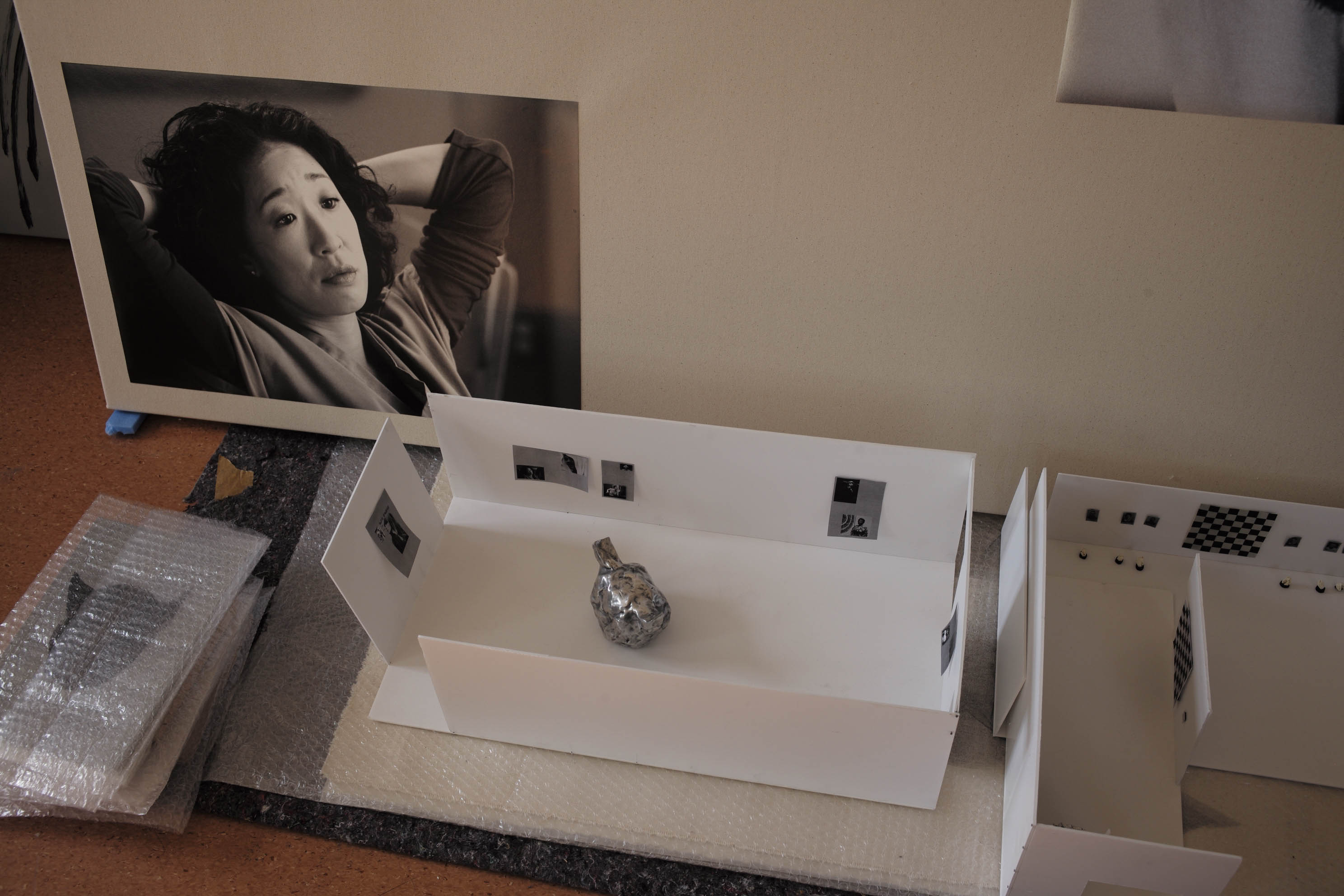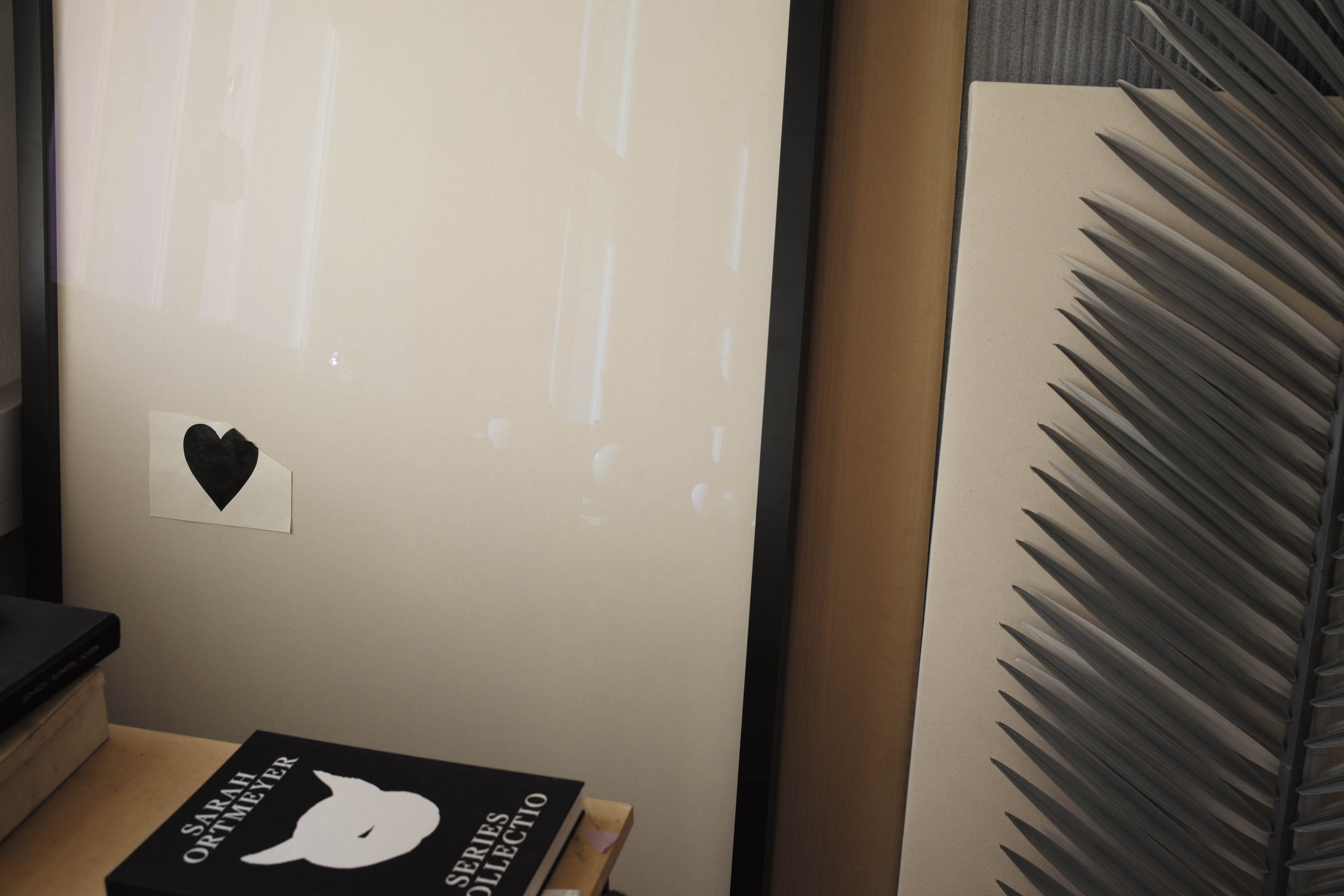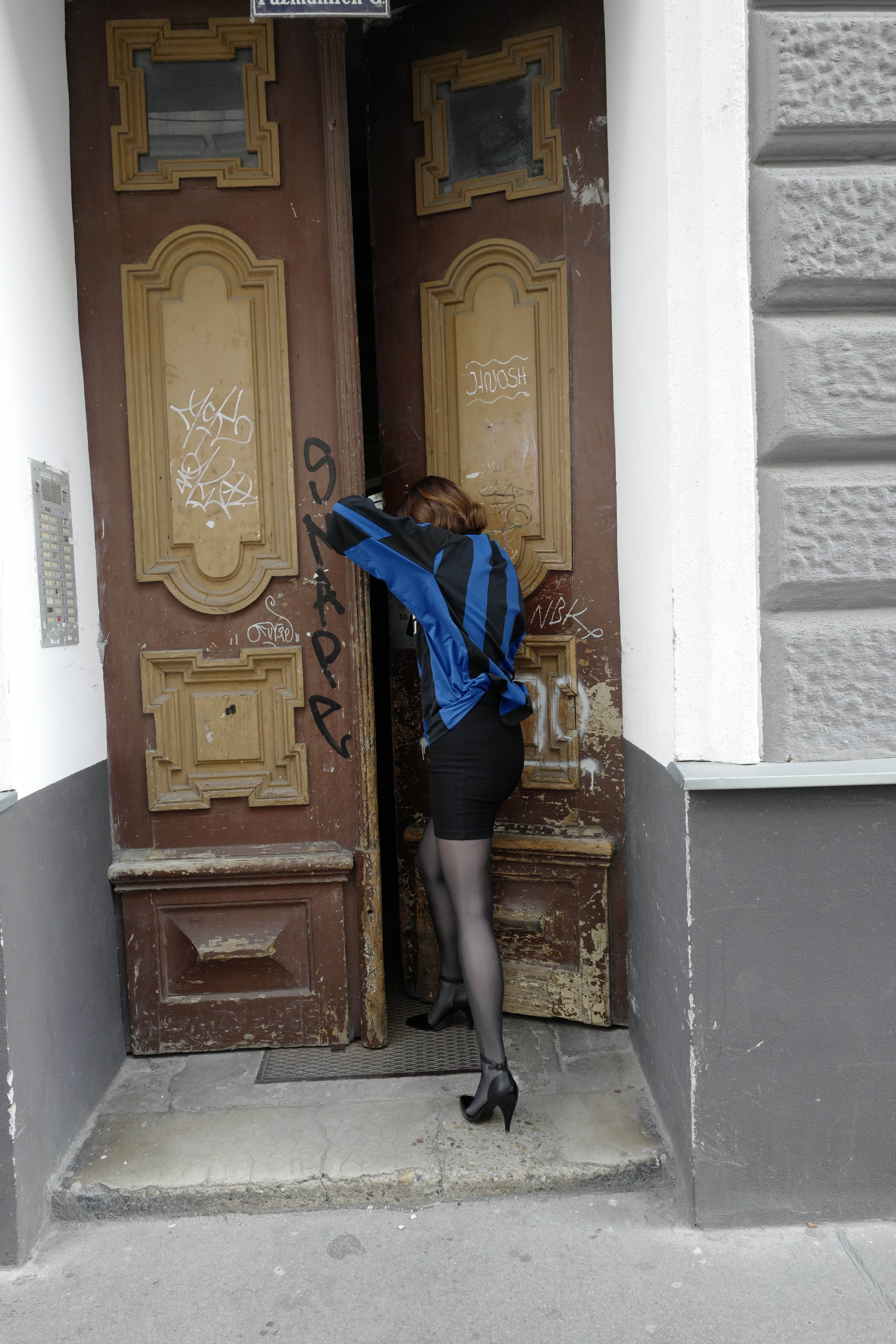SARAH ORTMEYER
Interview by Michael Bullock
Photography by Elfie Semotan
Apartamento 29, 2022

Chess boards, soccer players, spiders, hearts, ostrich eggs, devils and palm trees, German-born artist, Sarah Ortmeyer is faithful to her family of co-opted icons that she continuously features in her work. So much so, that at this point in her career, these symbols represent her better than her own image. This is deliberate. In an era dominated by social media exposure, Sarah has pulled off something extraordinary: in the nearly 15 years since she first started exhibiting her art she has strategically kept her face and personality out of the press and off the internet. She considers herself “web shy.” A fact that I always found at odds with her open personality. Sarah is an artist with a highly specific point of view who is never afraid to be direct about what she thinks. Knowing her well for over a decade, I felt that after nearly 50 exhibitions, I might be able to convince her to evolve her relationship with privacy. An interview, I suggested, could lead to better communication with her audience. “Isn’t it time to let people know who authored this seemingly anonymous, elegant, obsessive body of work?” Intrigued by the challenge she reluctantly agreed.
Chess for Sarah is more than just a game; it’s a long-term love affair. Early on, it became a guiding light in her art and her life. It also brought her to Vienna, the Austrian capital where she’s lived on and off. She first moved there to finish her dissertation, which examined the relationship between chess, aesthetics, and politics, and it earned her a PhD in philosophy, making her an extremely rare person: a doctor of chess. In the years that followed she has produced an oeuvre that is deeply invested in exploring strategy, dedication, competition, winning and losing, and the big emotional arcs that humans experience as a result thereof. Sarah has shown in galleries and institutions all over Europe, the U.S., Asia and West Asia, activating each space with her sculptures, paintings and drawings, that embody her signature themes. Her reinterpretation and recontextualization of cliched icons, is like hearing a mega-hit pop song played by a classical orchestra. When I toured Sarah’s discerning apartment in March 2022 I noticed that her family of iconography was also very present in her home, with chess board patterns, devils, ostrich eggs, and palm trees everywhere. My visit came just days before her latest pieces were about to be shipped to New York City. This June her romance with athletics will be on full display at Galerie Eva Presenhuber in a new exhibition she named Sports Club New York.
So, this will be your first interview that goes beyond discussing your work and shares some of your personal life. I hear this makes you nervous.
Sarah: Oh, no … Not nervous, terrified.
Why?
I'm web shy. I'm just a very private person. I would rather pose for Playboy than share my inner thoughts with people I’m not close with.
But one can't even find a single image of you online, is that true?
It's not so easy to do. When I was young and living in New York, photographers were everywhere, I tried to not be in the photos. So far I've succeeded.
Most artists use identity and personality to promote themselves. It’s rare to do the complete opposite.
I’ve always been terrified about it. The first time I was asked to be in a magazine, I was shocked that they wanted to feature a photo of me instead of my work it seemed performative to me. At the same time, I'm glad that we are doing this now. I feel safe because we have known each other for over a decade, and in the end sharing is important, it’s all about human connection.
I love your strategy for staying off the internet. Please share your technique.
Before Instagram, when it was much more popular to have events professionally photographed, I didn’t want to offend the photographers, so I bonded with them. At the beginning of a party, I would tell them, “My husband doesn’t know I’m here. I would appreciate it if you wouldn’t take my picture.” After that we were on the same side and as a result there is no online record of my attendance at any events.
It’s such a graceful solution and it has always framed how I think of you. To me you’re a very elegant, refined person and I know you’re very specific about every decision you make.
What a beautiful compliment!
… but intellectually I think of you as someone who is hardcore about their values. The tension between your ideas and how you present yourself has always fascinated me. Anti-bourgeois values packaged in bourgeois aesthetics; like a wolf in sheep’s clothing.
My father is an activist. This is what he always taught me.
Most people use style to announce their value system but you…
… look some days like the CEO of Bank of America! I find I can be so much more effective this way. I find that most strangers trust you immediately when you are wearing a cashmere coat. My father dresses rather classic and it allows him the opportunity to say the most radical things and be heard. He is a little TikTok star. Did you know that?
Really? Doing what?
Yes. His students love him so much. They make TikToks with him every other day. They ask him very simple questions like, “Are all Nazis dumb?” and then he speaks about it. His videos get endless views.
I want to watch him. What’s his TikTok name?
@benjaminortmeyer. It’s all in German. I’m not on TikTok but I heard from a dear American friend that you can translate it easily.
Why did you choose Vienna?
I had a generous mentor, a German philosopher, Burghart Schmidt, who brought me to Vienna to finish writing my PhD in philosophy. When I arrived here from New York City, I felt like I had moved to a fancy rehab — I still feel like this sometimes. It’s a slower paced, calm existence. Sometimes I still long for New York, but during the pandemic all the things that I love about that city were not running so there were many benefits to being in Vienna: the city is stunning, you can walk everywhere, the apartments are really big, the train comes every heartbeat, you can swim in the river in the summer and the tap water comes directly from the mountains, is almost sparkling. So yeah, this is where I ended up this year.
So you’re actually Dr. Sarah Ortmeyer?
[Laughs] Officially yes. I guess this is why I was able to enter America last year during the travel ban.
What was the specific topic of your PhD?
It was about the relationship between chess, aesthetics, and politics. I’m still shy about sharing that. I started it when I was 25. That same year I was in an exhibition in collaboration with Yoko Ono in Frankfurt. That was the first time I presented a work about chess. It was a silent piece. I invited the public to play chess on the steps of the museum, every Sunday at 10 AM and 10 PM. I drew the chess boards with chalk. The mornings were not that crowded but every Sunday night, there were lots and lots of people drinking and playing chess. It was quiet, people were thinking, instead of talking. It was the first silent party I have ever gone to. I’m sometimes sound sensitive; even though I grew up in Frankfurt, techno is not my thing. It’s too much for me. I made a postcard for this exhibition, it was gold and I adopted a photo of Yoko Ono playing her most famous, all-white chess set. For my PhD, I read a lot about the chess works she created when she was a member of Fluxus. The director of the museum thought it was too risky to use her image on the invite. He was scared that she would sue us for copyright infringement. I assured him I would take full responsibility. I love a good risk. I was convinced that it would be okay and it was. Actually, Yoko happily ordered a bunch of copies of the invitation to her home in the Dakota building.
Is that how you ended up meeting her?
Yes, she came to meet with the students who participated. There were bodyguards surrounding the school the days before. When she arrived, we had a lovely lunch at the director’s office during which she made a statement that most artists cannot live from their art. She asked each student what our backup plan is. Most students answered: carpenter, teacher, journalist…
And what was your backup plan?
I told her I might marry a rockstar.
[Laughs.] This story is fascinating to me because Yoko Ono is obviously a legendary, historical figure both in pop culture and art history, but it’s also a known fact that, before marrying John Lennon, she was born into a wealthy family. So, her question was kind of off-putting. Your response balanced an uneven power dynamic.
That’s an interesting way to say that. I’m often quick. A good punchline comes easy to me. I rarely leave a room and say, “I wish I could have said this.” My answers are often tough and fast but at the same time… have you heard the expression “hurt people hurt people?” I don’t think that it’s a good way to live. I was in my early 20s and that’s how I handled it. In retrospect, of course, it’s more interesting to ask a counter question and open things up to a real discussion — instead I jumped directly to the punchline. Quick thinking is mostly considered a strength, it can actually be a terrible weakness.
I never thought about it like that. But what about in chess? That’s where quick thinking is useful. Can you tell me more about your dissertation?
Chess became a big love and what’s so interesting is that al lot of friends and colleagues joined the affair.
How did this love begin?
Like real love it found me. I was not searching for it. It fell into my life and never left.
It seems that writing a scientific book about it allowed you to fully explore that instinct and now chess has become a main subject of your art. At this point you have made many different types of art about it, including several chess board paintings.
Sarah: They come very naturally to me. I make a few a year, without thinking. Every chess board painting I have made so far consists of two parts: one chess board square is black, the other square is always painted the same color of the sky. When I make them in Vienna it’s much more gray and silverish, in New York, it’s often more blue, in Los Angeles it’s more pinkish or orange. I don’t have to travel to make different boards because the sky is different every day, though the variations get wider with travel.
Do the titles include the location?
No, the title is always GRANDMASTER. I think it’s not even important to know about the sky. The German word for sky is Himmel which is also the word for heaven, so these paintings have a lot to do with heaven and hell, darkness and light.
In your exhibition arrangements, there’s a very particular way of arranging your work in a room that activates the whole space.
One aim of mine is that the viewer does not just have one brief look and leave. One of the most beautiful art experience I ever had…it sounds so boring, how it starts. I did a commission for Swiss Re, this big insurance company that insured the Twin Towers. For their New York headquarters, they commissioned one of my biggest chess board paintings. They placed it very beautifully, it now hangs on a wall next to a window that has a view of the Empire State Building. It's not open to the public. It can only be seen by the people who work there. I came for the install and the headquarters were not finished. When I arrived the construction workers were very engaged with the work, taking selfies with this painting. They spoke with me about their own experiences with chess. That touched my heart. I’m constantly challenged by my profession and that gave me so much strength that it’s worth it. I hope this story is not too kitsch.
Not at all. How do you define kitsch?
Over the top. I think my work is under the top.
Did you ever consider doing something else other than being an artist?
Yes. Everyday.
What would you do, if not art?
I think I could be interested in almost every profession. It’s weird when people say congratulations when you open a show. They wouldn’t say that to a baker. When you get some bread, you don’t say, congratulations. You just get the bread. So sometimes I’m very torn with my profession.
Are you describing imposter syndrome?
No. That’s probably the only syndrome that I never had in my life. I’m always joyful to go to my openings and I don’t have a lot of conflict within my own work. I guess that doesn’t sound humble, to put it this way: it’s just that my work makes me happy, so imposter syndrome has nothing to do with it.
One thing I enjoy about your art is that it straddles worlds. You have collaborated with, a very young rapper, a very old poet and created the black heart logo for Performance Space New York. You take cliché symbols like palm trees, devils, hearts, or the Eiffel Tower, and then you elegantly abstract and recontextualize them so the viewer has a new experience with them. To me your work is like hearing a mega hit pop-song being played by a classical orchestra.
Oh wow. Thank you, Michael. The subject is mainstream, the outcome is spiritual.
Is recontextualizing kitsch or clichés something you think about?
No, I guess it’s subconscious. You asked me how I create an exhibition space. Of course, I build models for gallery and museum exhibitions. I’m not fully organized in the beginning and have no idea how it’s going to be. The day I finished my PhD, I could no longer see a single part of my floor, it was just paper and books everywhere and so when I came out of the ashes, I cleaned the mess up and luckily I had created something that I could take out of it. It’s very similar to exhibitions, the studio becomes a total mess and what comes out of it is precise and final. Once it is all installed, I often change pieces around. It’s important to me to get opinions from other people. I’m not afraid, I love critique from everyone. I have gotten excellent advice from security guards, office workers, people who clean the space. Oftentimes they have a better eye than the artist because they know the space best and see a different perspective..
How does your experience with exhibition design affect your personal interior design? I see so much signature Sarah Ortmeyer iconography in your apartment.
So often it’s gifts. Almost every day I get one email or text from a friend or colleague who sends me an image of a chess board, palm tree, or a devil –– like you did on Valentine’s day.
Do you live with a lot of your own art?
At the moment I do. It’s testing for me, to be with the piece a little bit longer and at night. I don’t know why I didn’t bring them back to the studio yet … maybe it’s at times soothing to my eyes because they came from my own body? I’m not sure.
I noticed that none of the furniture in here is made of wood.
It’s true. I have a difficult relationship with wood. It’s not my favorite material. I have a beautiful wooden floor in the apartment and I struggle with wood on wood. At first it wasn’t a conscious choice and one day, I realized, “I have a lot of other materials on this wooden floor.” So, I never do wood on wood with my chairs or tables. I have leather and metal chairs and a marble table. Also in museums, I’m happy whenever there is non-wooden floor. You can see art better on other types of floors because wood is a living material, and it retains too many details — it’s in competition with the works. I have heard this from other artists too. It’s funny that MoMA has wooden floors.
You prefer a concrete floor, like the non-profit space in the Chicago garage [CHICAGO INFERNO, 2019, at Chicago Manual of Style] When I visited you there you were finishing installing the show and I was witnessing some behind-the-scenes drama. You had just found out that the imperfect ostrich egg you wanted to present had been broken and you were going to be forced to show a perfect ostrich egg in its place. You were horrified. In that moment I understood exactly how specific you are.
(Laughs) I have collected them for many, many years from a specific ostrich transfer. The distorted eggs are rare and they look very different. There was an accident at the preview of the show and it shattered. Everyone around me said it looks the same. It looked very different and in the end it changed the whole show for me.
What is the difference in meaning to you between a perfect egg and a distorted one?
Luckily, I think perfection doesn’t exist in life. It was a very strong shape. In all the years I have collected them it was my favorite.
A lot of your work can come off as obsessive but the themes are simple, almost mundane. How do you become fixated? How do you decide when an icon becomes part of your visual language?
It’s very interesting for me to think about this together with you. It’s more like it comes naturally. It’s like falling in love. It does not feel like an obsession at all. When I start to work with something it stays. I’m faithful to the things I have chosen. It continues and continues and does not stop.
But what makes you fall in love?
Sarah: If we knew the answer to that we would no longer have songs, or books, or movies. I think it’s simple and uncomplicated.
Would you say that sports are one of the biggest loves of your life? Besides chess, I know you regularly play tennis and I recently found out that you also studied ping-pong?
Yes. I went to a training camp in the Austrian country side, in China Town when I was living in New York, and Korea Town when I was living in L.A.
Why so much ping-pong training?
Table tennis! I just thought about this last week for the first time. I haven’t had a meditation practice and table tennis is a sport that doesn’t allow you to think about anything else while you’re doing it. I used to play regularly and have stopped since the pandemic.
Do you know what draws you to competition?
Someone told me that football was invented so that men could have an opportunity to cry together once a week. I think that this is true. I’m a very emotional person, more emotional than I want to be sometimes. I accepted that just recently, that it’s okay to be this sensitive. Someone comforted me and said that it means that you care al lot. So, I can relate to sports, the competition, the dedication, the big losses, the big wins. All my work focuses on these aspects too.
Would you say you’re a romantic?
In chess a romantic move is not the most winning move, it’s the most beautiful one. So, yes, I wish to become a romantic one day.
